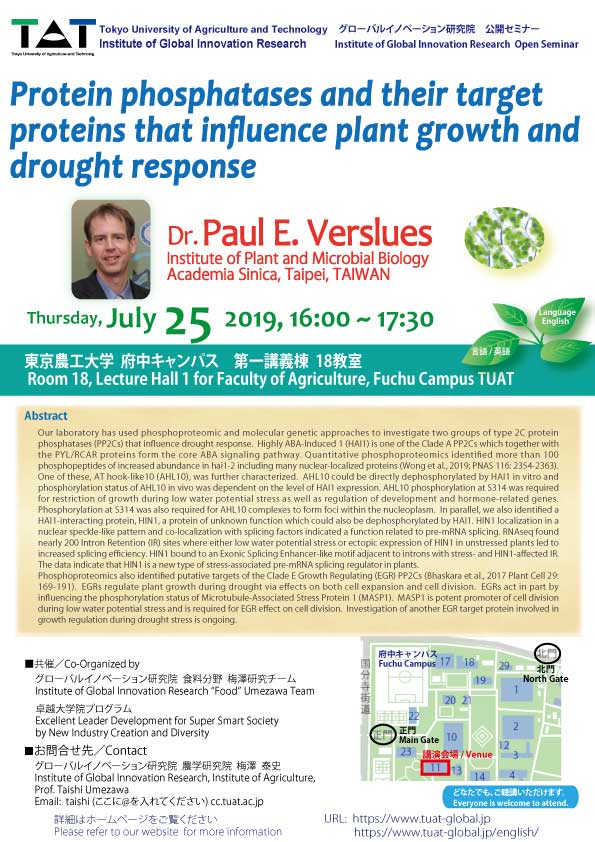Event
【GIR Open Seminar】Dr. Paul E. Verslues

| Date | 2019.7.25 (16:00 - 17:30) |
|---|---|
| Venue |
Room 18, Lecture Hall for Faculty of Agriculture, Fuchu Campus, TUAT |
| Title | Dr. Paul E. Verslues (Institute of Plant and Microbial Biology, Academia Sinica, Taipei, TAIWAN) "Protein phosphatases and their target proteins that influence plant growth and drought response" 〈Abstract〉 Our laboratory has used phosphoproteomic and molecular genetic approaches to investigate two groups of type 2C protein phosphatases (PP2Cs) that influence drought response. Highly ABA-Induced 1 (HAI1) is one of the Clade A PP2Cs which together with the PYL/RCAR proteins form the core ABA signaling pathway. Quantitative phosphoproteomics identified more than 100 phosphopeptides of increased abundance in hai1-2 including many nuclear-localized proteins (Wong et al., 2019; PNAS 116: 2354-2363). One of these, AT hook-like10 (AHL10), was further characterized. AHL10 could be directly dephosphorylated by HAI1 in vitro and phosphorylation status of AHL10 in vivo was dependent on the level of HAI1 expression. AHL10 phosphorylation at S314 was required for restriction of growth during low water potential stress as well as regulation of development and hormone-related genes. Phosphorylation at S314 was also required for AHL10 complexes to form foci within the nucleoplasm. In parallel, we also identified a HAI1-interacting protein, HIN1, a protein of unknown function which could also be dephosphorylated by HAI1. HIN1 localization in a nuclear speckle-like pattern and co-localization with splicing factors indicated a function related to pre-mRNA splicing. RNAseq found nearly 200 Intron Retention (IR) sites where either low water potential stress or ectopic expression of HIN1 in unstressed plants led to increased splicing efficiency. HIN1 bound to an Exonic Splicing Enhancer-like motif adjacent to introns with stress- and HIN1-affected IR. The data indicate that HIN1 is a new type of stress-associated pre-mRNA splicing regulator in plants. Phosphoproteomics also identified putative targets of the Clade E Growth Regulating (EGR) PP2Cs (Bhaskara et al., 2017 Plant Cell 29: 169-191). EGRs regulate plant growth during drought via effects on both cell expansion and cell division. EGRs act in part by influencing the phosphorylation status of Microtubule-Associated Stress Protein 1 (MASP1). MASP1 is potent promoter of cell division during low water potential stress and is required for EGR effect on cell division. Investigation of another EGR target protein involved in growth regulation during drought stress is ongoing. |
| Language | English |
| Intended for | Everyone is welcome to attend. |
| Co-Organized by | Institute of Global Innovation Research “Food” Umezawa Team Excellent Leader Development for Super Smart Society by New Industry Creation and Diversity |
| Outline | |
| Contact | Institute of Global Innovation Research, Institute of Agriculture, Prof. Taishi Umezawa Email: taishi (at) cc.tuat.ac.jp |
このページの上部へ